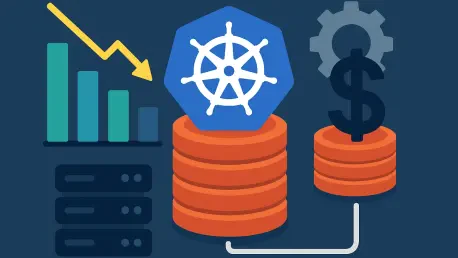Imagine a scenario where a tech enterprise, scaling rapidly with cloud-native applications, discovers that its Kubernetes infrastructure costs have surged by nearly 20% in a single year, threatening to derail its budget. This is not an isolated case but a growing reality for many organizations leveraging Kubernetes, the leading platform for container orchestration. As businesses increasingly rely on this technology to manage containerized workloads with agility and precision, the financial burden tied to its deployment has become a pressing concern. This review delves into the escalating costs of Kubernetes, dissects the underlying drivers, explores emerging solutions, and evaluates the path toward sustainable cost management in enterprise IT environments.
Understanding Kubernetes and Its Cost Dynamics
Kubernetes, often abbreviated as K8s, stands as a cornerstone of modern cloud computing, enabling organizations to orchestrate containerized applications with unparalleled scalability and flexibility. It automates critical tasks such as deployment, scaling, and management of applications across clusters of hosts, making it indispensable for businesses aiming to maintain a competitive edge through rapid innovation. Its architecture supports dynamic workloads, ensuring resilience and efficiency in diverse cloud environments.
However, the total cost of ownership (TCO) associated with Kubernetes has emerged as a significant hurdle. As adoption grows, enterprises face mounting expenses that strain IT budgets, encompassing not just infrastructure but also operational and human resource investments. This financial challenge is amplified in the broader context of cloud computing, where cost overruns can undermine the very benefits of agility and speed that Kubernetes promises.
Key Drivers of Kubernetes Cost Increases
Overprovisioning and Resource Waste
A pervasive issue in Kubernetes deployments is overprovisioning, where resources are allocated far beyond actual needs to safeguard against performance bottlenecks. Developers often err on the side of caution, provisioning excess CPU and memory to prevent downtime, which results in cluster sprawl and significant inefficiency. For instance, many workloads operate at a fraction of their allocated capacity, with some running at less than a quarter of CPU usage for extended periods, highlighting a massive waste of resources.
This practice not only inflates costs but also complicates cluster management, as unused resources remain tied up in idle states. The ripple effect is felt across cloud service bills, where organizations pay for capacity that delivers no tangible value, underscoring the urgent need for more precise allocation strategies.
Operational Complexity and Labor Costs
Managing Kubernetes at scale introduces a steep learning curve and substantial operational overhead, contributing heavily to labor costs. The platform’s intricate nature demands specialized expertise, often commanding high salaries for platform engineers who navigate its complexities. These financial pressures are compounded by productivity losses when developers spend disproportionate time troubleshooting or maintaining clusters instead of focusing on innovation.
Beyond salaries, the cost of inefficiencies in cluster management adds up, as teams grapple with dynamic workloads and unpredictable scaling needs. This operational burden often translates into hidden expenses, as misconfigurations or delays in addressing issues further inflate the economic impact on enterprises.
Emerging Trends in Cost Management
The landscape of Kubernetes cost optimization is evolving rapidly, with artificial intelligence (AI) and automation tools gaining traction as pivotal solutions. These technologies enable dynamic resource management by analyzing usage patterns and adjusting allocations in real time, reducing waste and enhancing efficiency. A staggering 92% of practitioners are now investing in AI-driven tools, reflecting a strong industry shift toward intelligent cost control mechanisms.
Additionally, the adoption of FinOps practices is reshaping how organizations align financial and operational objectives. By integrating cost accountability into engineering workflows, FinOps fosters a culture of transparency and efficiency, ensuring that Kubernetes deployments are not just technically sound but also fiscally responsible. This convergence of technology and financial strategy marks a significant trend in tackling cost challenges.
These advancements signify a broader movement within the industry to prioritize proactive cost management over reactive fixes. As vendors roll out features like autonomous rightsizing and intelligent autoscaling, enterprises are better equipped to navigate the financial intricacies of Kubernetes without sacrificing performance.
Real-World Applications and Cost Implications
Kubernetes finds extensive application across sectors like technology enterprises and cloud-native businesses, where its ability to manage complex, distributed systems is invaluable. However, the cost challenges in these industries are pronounced, as scaling operations often lead to spiraling expenses tied to infrastructure and support. The financial stakes are high, especially for organizations dependent on continuous deployment and innovation to maintain market position.
A specific example comes from a tech firm that reported an 18% increase in Kubernetes-related costs, driven by overprovisioning and labor-intensive management practices. This case illustrates the tangible impact of inefficient resource allocation and the pressing need for optimization strategies that can curb such escalations. It serves as a microcosm of the broader struggles faced by many in the sector.
These real-world scenarios emphasize that while Kubernetes delivers operational benefits, the associated costs can offset gains if not addressed strategically. Industries leveraging this technology must balance the drive for innovation with the imperative of cost containment to ensure long-term sustainability.
Challenges in Achieving Kubernetes Cost Efficiency
Achieving cost efficiency in Kubernetes deployments is fraught with obstacles, notably the misalignment of incentives between developers and financial teams. Developers often prioritize speed and reliability, leading to resource-heavy configurations, while financial stakeholders push for cost reductions, creating friction that hinders optimization efforts. This disconnect frequently results in hidden waste and fragmented accountability.
Another significant barrier is the lack of expertise in orchestration and control plane management. Many teams approach Kubernetes with outdated mindsets, treating it akin to static servers rather than a dynamic platform, which leads to suboptimal usage and orphaned assets. This knowledge gap exacerbates inefficiencies and inflates operational costs.
Efforts to overcome these hurdles include enhanced training programs, development of user-friendly tools, and fostering organizational alignment through cross-departmental collaboration. While progress is being made, the complexity of Kubernetes ensures that these challenges remain a persistent concern for many enterprises striving for fiscal balance.
Future Outlook for Kubernetes Cost Optimization
Looking ahead, the potential of AI and machine learning to transform Kubernetes cost management appears promising. These technologies are poised to revolutionize resource allocation by enabling predictive autoscaling and real-time adjustments based on historical and current data. Such innovations could significantly reduce waste and align resource usage more closely with actual demand over the coming years.
The long-term impact of these advancements hinges on striking a balance between cost control and the pursuit of innovation. As tools evolve, they are likely to influence enterprise adoption of Kubernetes by making it more financially viable for a broader range of organizations. This evolution could redefine how businesses approach cloud-native strategies.
Moreover, the integration of sophisticated cost management platforms with Kubernetes ecosystems is expected to enhance visibility and control. As these solutions mature, they may offer a pathway to sustainable deployment models, ensuring that financial considerations do not impede technological progress in enterprise environments.
Reflecting on Kubernetes Cost Challenges and Solutions
Looking back, this exploration of Kubernetes cost optimization revealed a landscape marked by significant financial challenges, from overprovisioning to operational complexities, that tested the resilience of enterprise budgets. The review highlighted how these issues, compounded by misaligned priorities and expertise gaps, have created a pressing need for innovative approaches. The emergence of AI and automation stood out as a beacon of hope, offering tools that tackle inefficiencies with precision.
As a next step, organizations should prioritize the adoption of intelligent cost management solutions, focusing on tools that provide actionable insights and automate resource adjustments. Investing in training to bridge knowledge gaps and fostering collaboration between technical and financial teams can further align efforts toward efficiency. Ultimately, viewing Kubernetes not merely as a cost but as an investment in agility and innovation can guide enterprises in navigating this complex terrain with a forward-thinking mindset.









